Derby branch
Click on the image above to open a pdf of the early tree for this branch.
Press the back button on your web browser
to return to this page.
So far, we have 524 people on this tree.
We have use the following abbreviations on the tree:
b : birth
c : christening or baptism
m : marriage
d : death
bu : burial.
John Fairholm - moves to Derby but dies back in Nottingham
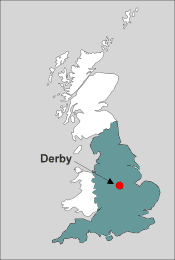
© Base map Corel Corporation
"death from injuries sustained on the
Midland Railway"
Inquest into the death of John Fairholm
John was a stockinger when he arrived at Derby and later a silk glover and a labourer. When he died aged 66 in an accident in 1875 he was a ganger on the Midland Railway. He was emptying ballast from wagons when the engine was moved and he fell between the wagons. It seems that had missed the signal for the engine to move due to the noise from the emptying of the ballast and from a passing passenger train. He was taken to the General Hospital with a lacerated leg and other injuries, but died nineteen days later. An inquest was held on 25.3.1875 and 30.3.1875 under Mr. Browne, coroner for Nottingham.
William Fairholm & his glass eye
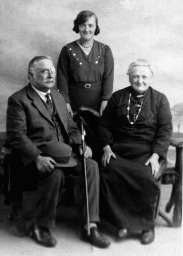
The photograph shows him in later life with his wife, Emma, and their youngest daughter, Grace Constance.
Joseph Fairholm - soldier, tea merchant, baker, farmer, ferryman
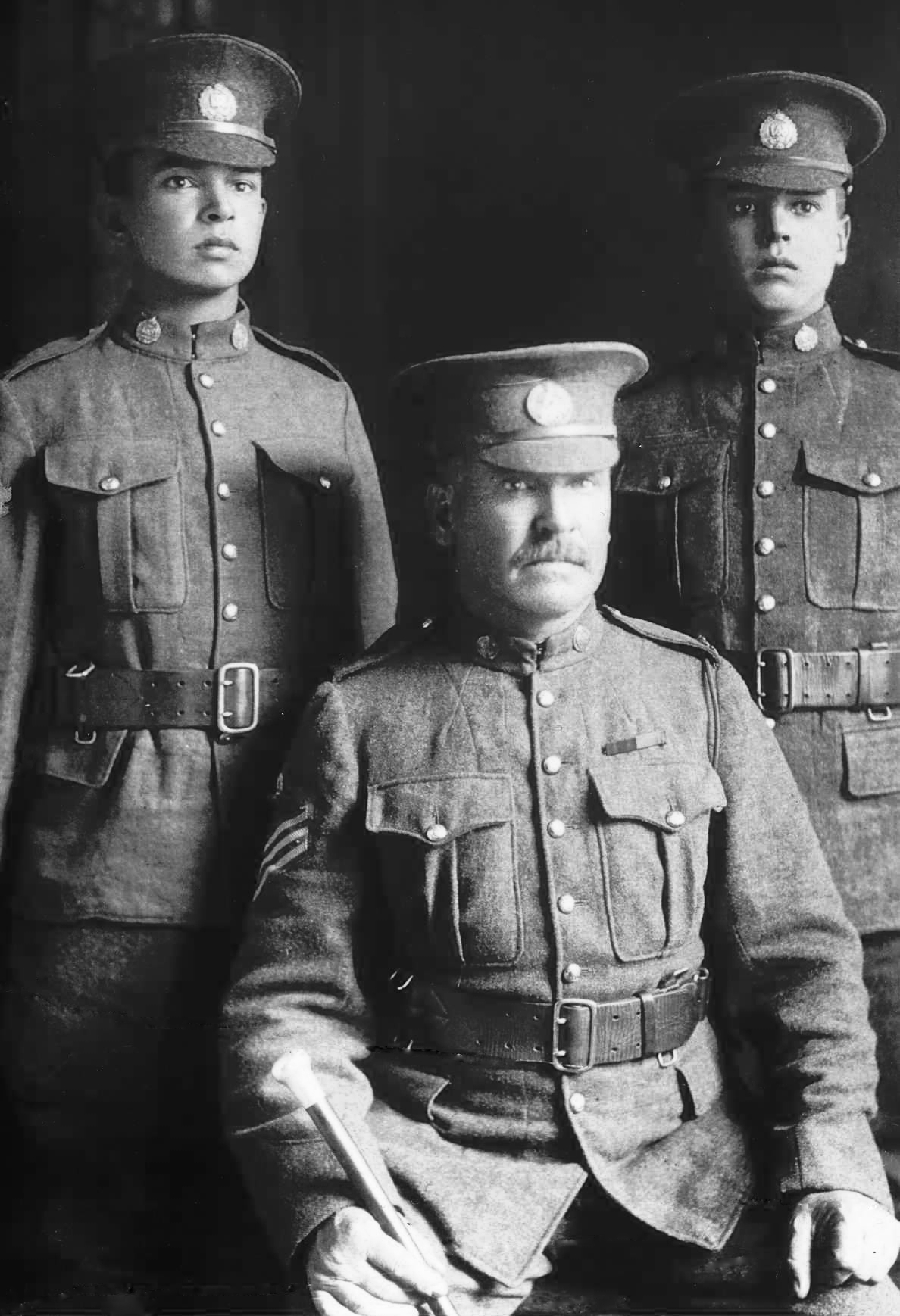
This photograph was shared by Mark Townsend
Annie Webster Married 1890 Derby - Divorced 1896 Derby
Maud Dickson Married 1896 Ceylon - Died 1900 Ceylon
Amy Beatrice Robinson Married 1901 Ceylon - Died 1920 Canada
Florence Ethel Rose Robinson ("Queenie") Married 192? Canada - Divorced 1931
Joseph's first marriage took place in Derby only two days before he was due to embark for India as a soldier in the British Army. He married without the consent of his commanding officer and so Annie could not accompany him abroad. The divorce made the News of the World, as well as the more local newspapers - divorce was a unusual event at the time and the circumstances made for a racy story. The grounds for the divorce were infidelity on the part of Annie with Henry Coxon and John Banks. From the various reports and the court papers it seems that Joseph's elder brother, William, was deeply involved in the case, in his brother's absence in Ceylon (now Sri Lanka).
Joseph served with the Royal Warwickshire Regiment in India, Singapore and Hong Kong and Ceylon. Later he was a Sergeant Major in the Ceylon Volunteers Corps before returning to England. Back home he became a tea merchant (selling tea from a plantation in Ceylon) and then a Master Baker in Birmingham. The family had a comfortable lifestyle, but in 1913 Joseph and the family sold up and migrated to Canada to become farmers. According to the life story of Amy Mona, (Joseph's eldest daughter) it was a hard life. In later years, Joseph ran the ferry across the McLeod River.
The photograph shows Joseph (centre) and his two eldest sons, Joseph Goldie (right) and Bertam Noel (left) after they had signed up for the Canadian Expeditionary Force in World War 1. All three survived the war and returned to Canada. A diary written by Joseph Goldie during his time posted to Western Europe has been discovered in Wales. It was returned to the family in Canada in August 2014. The diary covers the period from 30 November 1916 to 19 November 1917 and decribes details of Joseph Goldie's experiences as a machine gunner and runner. There is an article about it on the website ww1.canada.com (the link will launch a new window).
Maud Simpson (nee Fairholm) & Elk Lake
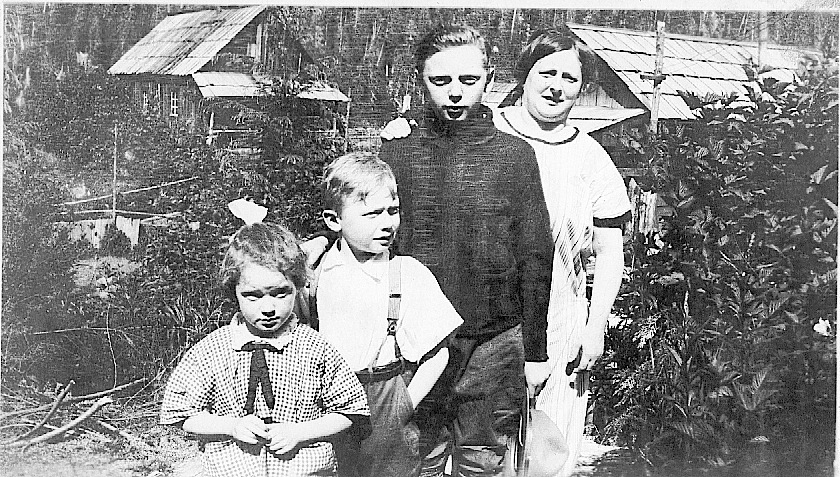
This photograph was shared by Clifford Simpson
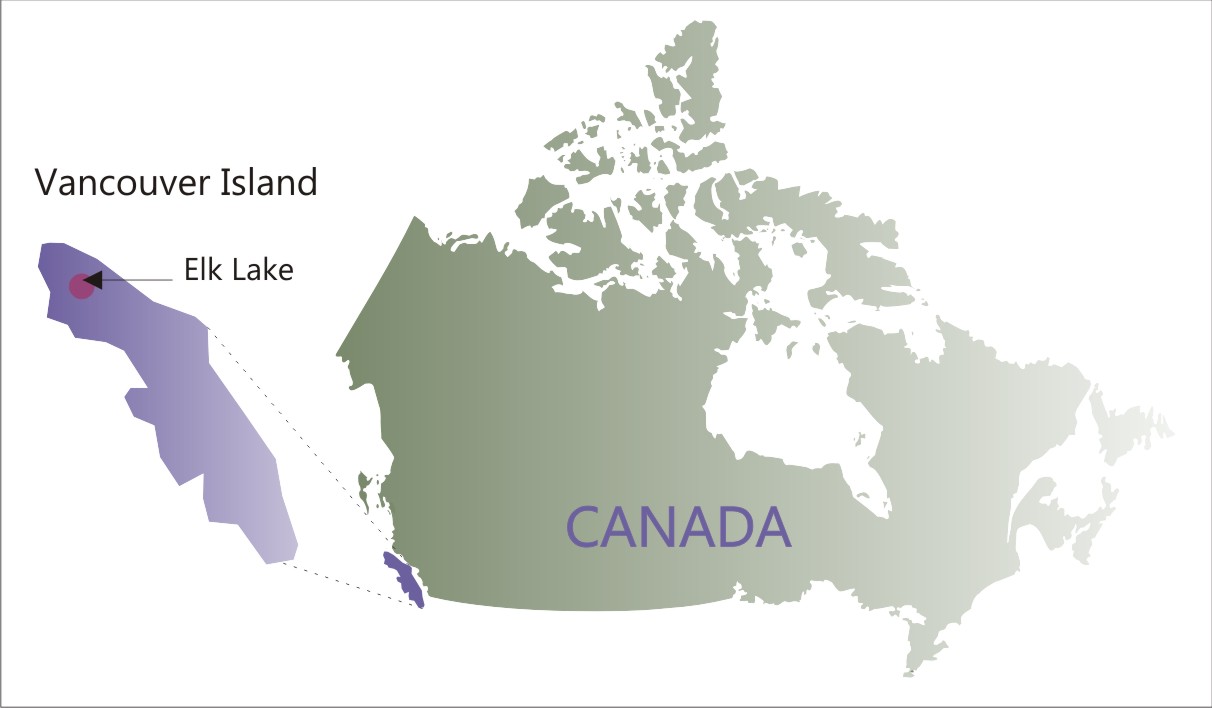
© Base map Corel Corporation
They had moved to Vancouver by 1919, where Tom had a car workshop. In 1924 he joined a subsidiary of the Consolidated Mining & Smelting Company and the family moved to Vancouver Island. Tom was in charge of installing and maintaining equipment for prospective boring for copper ore near Elk Lake (now Benson Lake).
The family went from Vancouver City by supply boat, which called in at small settlements and lumber camps up the eastern side of Vancouver Island, until they reached Jeune Landing on the north-western edge. It took over 4 days to complete the journey of approximately 200 miles. From there, they went on horseback or walked along rough gravel tracks to reach Alice Lake, which they crossed by boat. A further track took them to Kathleen Lake and another boat crossing. The final stage was another track that took them to Elk Lake and the site that was to be their home for almost 8 years. The total distance from Jeune Landing was about 13 miles, of which 6 miles was by boat. The first time they under took the trip, their children were 3, 5 and 9 years old. It was a trip that Maud and the children completed many times when they returned to Derby for holidays. The photograph shows Maud and her children at Elk Lake.
The facilities were extremely basic. They lived in a wooden shack with wood burning stove and range, but there was electricity for lighting from the company's water powered generator. In winter snow falls could be 90cm (3ft) deep and summers as hot as 32oC (90oF). A school was built in 1926, but there was no doctor or nurse all the time they lived there. Supplies were delivered by boat to Jeune Landing approximately every three weeks, but as this could not be guaranteed, Christmas presents usually arrived in October and were hidden away. All the supplies were dragged along on horse-drawn sleds called go-devils. Rough or boggy parts of the tracks were covered with split tree trunks and others formed kerbs and helped to keep the sleds on track.
After almost nine years the prospecting was not viable commercially and the operation was closed in 1932. The family returned to England and settled in Derby.
Derby - Near the Royal Infirmary

Reproduced courtesy of Nottingham City Council Local Studies Library / www.picturethepast.org.uk.
Picture the Past provides access to a large collection of photographs of Nottinghamshire and Derbyshire for viewing on-line and for purchase.
William (senior) lived at John Street (centre right), 3 Hope Street (centre left) and 28 Copeland Street (centre top) between at least 1863 and 1868. In 1869 through to at least 1877 the family was settled at 70 Liversage Street (centre left). The photograph shows part of Liversage Street in 1970 - shortly before demolition.
When Joseph married Annie in 1890 his marriage certificate states that they were both living at Eagle Street (top left corner) - he at No 70 and she at Court 5, House 5.
The map shows a mix of residential, industrial activities, although the uses of the industrial properties changed between the time that the family lived there and the date of the map. For part of his working life John was a silk glover and William (senior) was in the metal work industry. It is very likely that they worked in the area in which they lived, but not necessarily at the silk mills or the iron works shown on the map. It is interesting to note that there are four schools on the map, five places of worship - and eighteen inns, taverns or public houses. For a while, John was the landlord of the British Lion beerhouse on Siddals Road. He was fined in 1864 for having parties at midnight on a Wednesday.

OS Map 1914. Image produced from the www.old-maps.co.uk service with permission of Landmark Information Group Ltd and Ordnance Survey
Derby - New Normanton
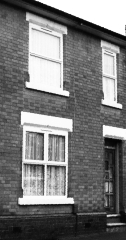
This area is much more residential than the area near the Royal Infirmary - there is only one mill and one public house.
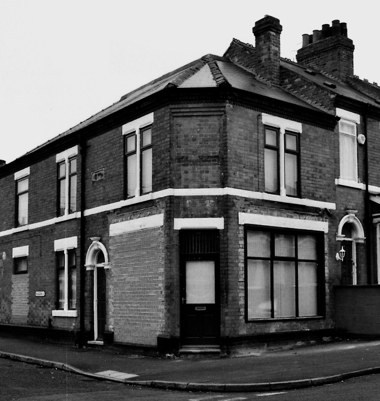 |
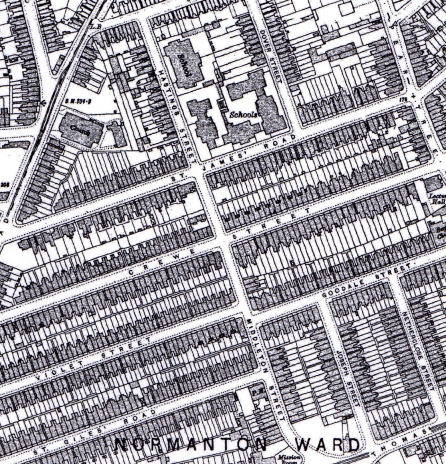 OS Map 1914. Image produced from the www.old-maps.co.uk service with permission of Landmark Information Group Ltd and Ordnance Survey |
Haydn Fairholm & war
“Has served during the campaign in a most trustworthy and diligent manner. He has spared no effort to do his duty and has proved himself to be most conscientious in everything he has done. He is thoroughly honest and is highly recommended to his future employer. Character – Exemplary.”
The small left hand image is of Haydn as a young man. The main image shows him and his unit. The larger left hand image is of his army driving licence for 1944-1945.

Harold Fairholm & his violin

The review in the Derby Daily Telegraph of 29 September 1906 of his performance at the Rose Hill Wesleyan Church's annual conversazione notes that “to all lovers of music his perfect rendering of the solos was a revelation.” Other performances around this time, often for church organisations or charities, met with equally positive reviews and he often received encores. Pieces that he performed regularly included Pensees Religieuses (Henry), Souvenir de Posen (Wieniawski), Salut d'Amour (Elgar) and Largo in G (Handel).
In 1914 Harold joined the resident orchestra of 14 musicians at the Grand Theatre at Derby and two years later became its musical director, a post that he held for thirteen years. He also played for the D'Oyly Carte Opera Company (which performed the works of Gilbert & Sullivan) and the Carl Rosa Opera Company when their provincial tours came to Derby. In 1930 he resigned from his post, but it is not clear as to the circumstances that lead to that, although it seems that the orchestras of the Grand and Hippodrome theatres were merged at that time, when the Hippodrome was converted to a cinema.
Harold continued to be involved in music in the town – running his own orchestra and , in 1938 he was the adjudicator of the Harmonica Contest that was held at the Central Hall. Two years later, he donated the violin that he had played at the Grand Theatre in response to an appeal for a replacement violin (and also a mandolin) for soldiers serving in Europe who had lost their own instruments. He is quoted as saying “I hope that the boys will have a happy time with it”.
He died in 1964, aged 74. There was a short obituary for him in The Stage magazine.
More family photographs
The middle left photograph is undated, but is probably taken in 1935 or 1936 outside the house on Chellaston Road, Derby. From left to right are Haydn V. Fairholm, his sister, Grace Constance (seated), his father, William (junior), his mother, Emma (nee Clements) and his son, Peter (in her arms).
The middle right photograph shows Edgar Howard Fairholm (the second youngest son of William (junior)) and his wife Clara (nee Green). It was probably taken after 1927.
On the right is a photograph that we believe to be of Percy Fairholm.



Peter Fairholm - Duke of Derby
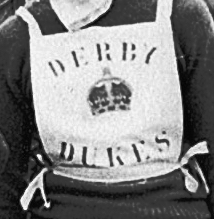
Cycle speedway was an amateur adaptation for bicycles of professional motorbike speedway. Initially, cycle speedway took place on redundant or derelict sites after World War 2. It used a small, narrow oval track, that was often covered in ash or cinder as the riding surface. The bikes or “clags” had ordinary frames, but with special tyres. Some riders opted for free wheels and others for gears. Many of the bikes did not include mud guards. The speed of the bikes, the style of riding and the tightness of the bends at the ends of the track meant that many collisions occurred.
Peter was taken to the nearby motorbike speedway circuit at Long Eaton - the home of the Long Eaton Archers team - by the son of a local grocer and was inspired to join the Derby Dukes, one of the cycle speedway teams that emerged in Derby as the sport was just taking-off in England. The Derby Dukes comprised 10-12 young men. They used several informal tracks during the team's existence, one within a loop of the railway network near the city centre.
The sport of cycle speedway continues today but, unfortunately, there is no successor team to the Derby Dukes or the other Derby speedway clubs operating in the city at the moment.
The left hand image below is of Peter on his clag and the other one shows members of the team (Peter is the second from the right).
If you were one of the other Derby Dukes then we would be very interested to hear from you at queries@fairholmfamilytrees.info.

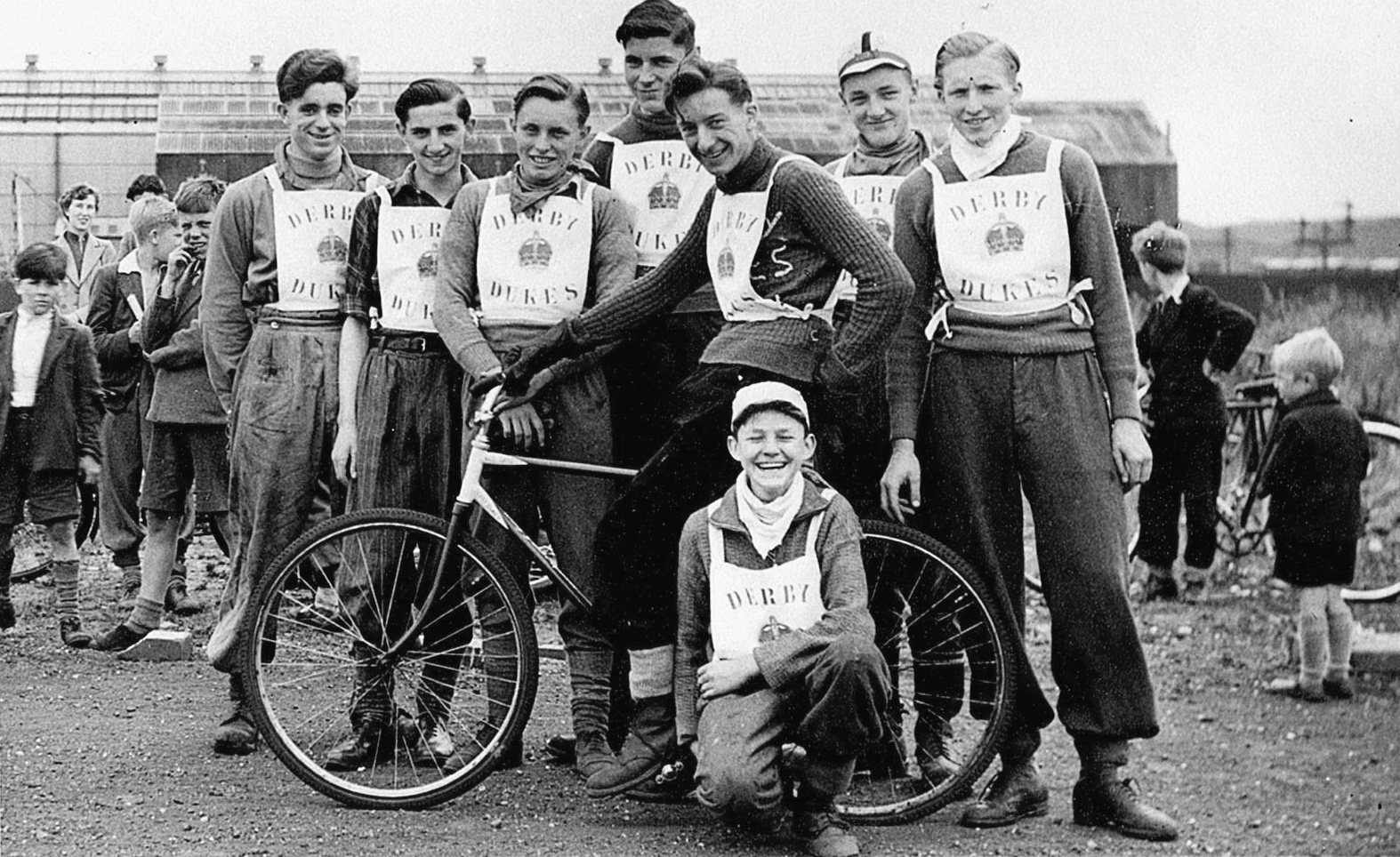
Amy Mona Fairholm

Image shared by Nancy & Rob Stagg
Growing up as the daughter of a solider, Amy Mona moved around south and east Asia until her father retired to civilian life in the Midlands in England when she was about 7. She recalled the family home at Rugby and various possessions, which included two large ming vases and a cheetah skin rug - the cheetah having been shot by her maternal great uncle and the skin given to the family. Amy attend a private girls school.
She describes her father as becoming restless after running a tea business and, later, bakeries for several years. Eventually, he decided to move to Canada as a farmer. Her family life in Canada started very differently compared to Ceylon or England - initially in a tent at Peers, Alberta. It changed dramatically again when the family home, with its post office and store burnt down in 1915. The family had to start from scratch, moving to Edmonton, but returning to farming in 1919. When her mother died in 1920 Amy Mona took over managing the family home for her father and her then seven siblings, which was an enormous task for a young woman.
Amy married and had three daughters and one son. The young family was badly affected by the Depression - and "just lived from hand to mouth" for some time, but things did improve eventually.
She and her husband moved home a couple of times between Alberta and British Columbia before settling near to Vancouver.
Amy Mona recalled all sorts of details of her early life in her story - from a fight of dogs under the dining table to the setting up of the local school to the effects of World War 1 on neighbouring immigrants from England and Germany to baking ten loaves of bread every other day to feed the family. Much of her early life in Canada seems to have been hard, but there were also times of happiness. Amy died in 1999 at the ripe age of 97.